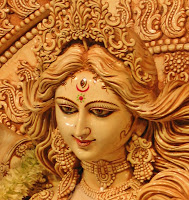Kolkata, a city in West Bengal, nicknamed as the 'Culture
capital of India’ is a place where art, architecture and culture flourishes
immensely. It is one of the most elegant places in India where all things get
along well.
The choice I made is because
it is most famous for its architectural heritages. As a former capital of India
this city is also credited with the title "The
city of joy”. The architectural master pieces of Kolkata include the Victoria
memorial, which is one of the finest art museums. This is about 184 ft tall and
constructed in 64 acres of land. The museum houses picturesque masterpieces of
art above the north porch that epitomizes prudence, learning and motherhood.
Victoria memorial, Kolkata
The significance of
this architectural building is that this was constructed for young writers to
engage in writing about culture. This
ginormous site is also known as ‘Mahakaran’.
This sumptuous white marble Victoria memorial is a copy of the Taj Mahal, opened
in 1911 surrounded by serene ponds on the sides situated on the banks of the
Hooghly River as the showpiece of the British Empire portraying the culture.
The other major
attraction in Kolkata is the Howrah Bridge. This long unwinding bridge which is
placed above the Hooghly River is a famous symbol of Kolkata. The illuminated
picture of this Howrah Bridge at night is such a visual treat.
Howrah Bridge, Kolkata
In the book “Lonely Planet the Cities Book: a Journey
through the Best Cities in the World” by Trent Holden, Anna Metcalfe says “Kolkata
is a land of poets and artists, with penchant for arts and culture and a level
of intellectual vitality” which
certainly describes Kolkata’s rich cultural and architectural heritage in a few
sentences.
The specialty of this bridge is that it has no pillars for its
support but it is hung by steel wires. Essentially, it does not have any
intermediate supports in between. It is supported on 2 pillars at each
end. It was the first of its kind in India so it was special. It even has
a high utility value since it connects to the suburban areas.
The culture in Kolkata
is fresh and special. Apart from architectural towers like the memorials,
museums, marble palace, the dance and festivals is one which put forward a
fresh look to Kolkata. The traditional festivals include Durga puja, which is
celebrated all over.
Durga puja festival, Kolkata
Durga
puja is a festival which is a special occasion that occurs in this city. This festival epitomizes
the victory of good over evil.
This is celebrated in a big level in Kolkata.
The dance forms of Kolkata are also very unique. Dandiya, kathak, odissi,
manipuri and some other dance forms are also famous in Kolkata.
As a cultural capital of
India, Kolkata stands unique in art, architecture and tradition. That is the
reason why I chose this as a city of culture.















